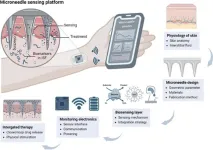(Press-News.org) Researchers have found evidence that mangrove forests – which protect tropical and subtropical coastlines – are drowning in the Maldives.
Their findings, published today (Tuesday 12 December) in Scientific Reports, indicate that rising sea level and a climate phenomenon known as the Indian Ocean Dipole have led to some Maldivian islands losing over half of their mangrove cover since 2020.
The research team, led by Northumbria University, warn that the findings have implications not only for the Maldives, but also for other island nations and coastal ecosystems around the world.
In 2020, more than a quarter of the Maldivian islands containing mangrove forests saw their trees experiencing a gradual deterioration before dying, a condition known as dieback.
Satellite imagery of both inhabited and uninhabited islands revealed the severity of this issue, showing that some islands lost over half of their mangrove cover.
Mangroves play an essential role in protecting coastal regions by acting as natural barriers against storms, erosion and flooding. As biodiversity hotspots they are vital nurseries for marine species such as crabs, prawns and fish making them crucial for food security and livelihoods in many coastal communities. They also provide valuable resources such as construction materials for housing.
A team of researchers, led by Lucy Carruthers and Vasile Ersek in Northumbria University’s Department of Geography and Environmental Sciences, combined evidence from sea level, climate data and remote sensing with field observations of sediment geochemistry and dendrology to investigate the mangrove dieback.
Their analysis of mangrove wood revealed that the dead trees showed greater signs of salinity stress compared to living trees.
This stress indicates that the roots of the trees were struggling to cope with increased salt levels, which was a key factor in their eventual death.
The researchers found that sea levels around the Maldives rose at an accelerated rate of over 30mm per year between 2017 to 2020. Towards the end of this period, an unusually intense climate phenomenon known as the Indian Ocean Dipole occurred. This caused warmer sea surface temperatures and an increase in sea level in the Western Indian Ocean.
Although mangroves naturally build up their own sediment, allowing them to adapt to gradually rising seas, this rate of sea level rise was too fast for the mangroves to keep pace.
As tidal movements are more limited in the basin areas where many mangrove forests grow, the rising sea level meant that seawater effectively flooded the forests. This lack of tidal movement and flooding prevented the mangroves from building the sediment they needed to stay above water. They eventually lost their resilience and died off by drowning.
Dr Vasile Ersek, Associate Professor in Northumbria University’s Department of Geography and Environmental Sciences explained: “Dieback was first observed in the centre of low-lying basin areas before gradually spreading outwards. As these basin areas have something we call limited tidal flushing we saw evidence of the rising sea level inundating the forests with seawater. This prolonged exposure created higher concentrations of salt.
“As the mangroves’ build-up of sediment slowed down due to the pace of the rising sea level, the soil salinity increased beyond what even these salt-tolerant trees could handle. Essentially, the mangroves were drowning.
“The extreme magnitude of dieback seen in the Maldives is a vivid illustration of how climate change may push natural systems past their limits, with cascading consequences for both nature and people.”
Lucy Carruthers, now a postdoctoral scholar in East Carolina University’s Department of Coastal Studies, led the project whilst working at Northumbria University. She said: “Sea level in the region reached its highest point on tide gauge records when the dieback occurred in 2020. This coincided with an intense positive phase in the Indian Ocean Dipole which can induce climate extremes for countries within the Indian Ocean.
“As our planet continues to warm, we can expect to see the Indian Ocean Dipole occurring more frequently and at higher magnitude, meaning events like this mangrove die-off may become more common.
“These remarkable forests have thrived at the interface of land and sea for many centuries. Whether they can survive the rapid changes of the coming decades will depend largely on our actions in managing the climate crisis today.”
The researchers noted there was published evidence of mangrove die off in other areas of the Indian Ocean around the same period, including the Seychelles and Madagascar,
As mangrove forests store massive amounts of carbon – typically three to five times more carbon per equivalent area than tropical rainforests – the researchers raised concerns that the loss of mangrove forests could also release large amounts of stored carbon, further accelerating climate change.
She added: “Our findings reveal the vulnerability of mangrove ecosystems to rapid sea-level rise and highlight the need for urgent adaptive conservation strategies in small island developing states.
“This may sound like a local problem, but it's a warning for coastal areas worldwide. As climate change and extreme events intensify, some mangrove forests may struggle to keep up with sea level rise. The Maldives, as the world's lowest-lying nation, can therefore potentially be the canary in the coal mine.”
The study, Sea-level rise and extreme Indian Ocean Dipole explain mangrove dieback in the Maldives is now published in Scientific Reports.
END
“Drowning” mangrove forests in Maldives signal global coastal threat
Researchers have found evidence that mangrove forests – which protect tropical and subtropical coastlines – are drowning in the Maldives.
2024-11-12
ELSE PRESS RELEASES FROM THIS DATE:
When muscles work out, they help neurons to grow, a new study shows
2024-11-12
There’s no doubt that exercise does a body good. Regular activity not only strengthens muscles but can bolster our bones, blood vessels, and immune system.
Now, MIT engineers have found that exercise can also have benefits at the level of individual neurons. They observed that when muscles contract during exercise, they release a soup of biochemical signals called myokines. In the presence of these muscle-generated signals, neurons grew four times farther compared to neurons that were not exposed to myokines. These cellular-level experiments suggest that exercise can have a significant biochemical effect on nerve growth.
Surprisingly, the researchers also ...
Smokers who switch to vaping see improved respiratory health
2024-11-12
A new paper in Nicotine and Tobacco Research, published by Oxford University Press, finds that people who switch from smoking cigarettes to vaping see improved respiratory health, but people who begin consuming electronic cigarettes while continuing to smoke regular cigarettes do not report improved respiratory symptoms.
Adults increasingly use electronic cigarettes to try to quit smoking because of the perceived reduced risk. But while vaping reduces exposure to toxic chemicals, it has been unclear whether switching from cigarettes to e-cigarettes results in a reduction of the respiratory problems—like wheezing and coughing—common in regular cigarette ...
Air pollution emerges as critical environmental risk factor for autism, emerging topic review finds
2024-11-12
Boston, Massachusetts, 12 November 2024 – Environmental exposure to air pollutants during critical developmental periods may significantly impact autism risk, according to a groundbreaking Emerging Topic review published 12 November 2024, in Brain Medicine. The study reveals how common air pollutants, including fine particulate matter and nitrogen oxides, can trigger complex biological cascades affecting brain development.
"Different kinds of neurological disorders, including autism spectrum disorder, can be associated ...
Autism and nitric oxide: Professor Haitham Amal unveils brain disorder breakthrough
2024-11-12
Boston, Massachusetts, 12 November 2024 – The complex interplay between nitric oxide and brain disorders takes center stage in the latest Genomic Press Interview, published November 12, 2024, in Brain Medicine. Professor Haitham Amal, head of the Laboratory of Neuromics, Cell Signaling, and Translational Medicine at the Hebrew University of Jerusalem, shares insights into his groundbreaking research and personal motivation.
“Meeting families and children with autism in Boston during my time at MIT inspired me to focus on a single goal: to help develop biological diagnostics ...
Facing the wind: How trees behave across various forest settings and weather events
2024-11-12
Destructive winds during storms and cyclones often cause tree failures, especially through uprooting and stem breakage. However, how trees respond to wind under various forest configurations and weather conditions remains unclear. A recent study on Cryptomeria japonica plots shows that trees dissipate wind energy by switching between two swaying behaviors at specific wind speeds, offering insights that may help in improved forest management to minimize damage caused by storms.
Extreme weather events, such as tropical and extratropical cyclones and tornadoes, can cause widespread damage to forests, leading to environmental and financial ...
High-performance inkjet print head enhances bioprinting productivity
2024-11-12
Bioprinting is a technology used to create three-dimensional structures, such as human tissues or organs, using bio-inks made of cells and hydrogels. However, conventional inkjet technology has difficulty dispensing bio-inks that are sensitive to temperature due to the heat generated during operation. Furthermore, conventional 3D bioprinting mainly utilizes simple syringe-type printing devices with a single needle, making it time-consuming to produce artificial organs like the brain, lungs, and heart.
The Bionics Research Center team, led by Dr. Byung Chul Lee at the Korea Institute of Science and Technology (KIST, President Sang-Rok Oh), in ...
Opioid use disorder: Updated clinical practice guideline
2024-11-12
La version française suit
Opioid use disorder: updated clinical practice guideline
An updated evidence-based guideline aimed at helping clinicians and other health care providers manage patients with opioid use disorder recommends buprenorphine and methadone as first-line treatments. The guideline is published in CMAJ (Canadian Medical Association Journal). https://www.cmaj.ca/lookup/doi/10.1503/cmaj.241173
Opioid use and opioid use disorder are the leading causes of drug-related deaths worldwide, and Canada ...
Microneedle sensors for dermal interstitial fluid analysis
2024-11-12
The rapid advancement in personalized healthcare has driven the development of wearable biomedical devices for real-time biomarker monitoring and diagnosis. Traditional invasive blood-based diagnostics are painful and limited to sporadic health snapshots. To address these limitations, microneedle-based sensing platforms have emerged, utilizing interstitial fluid (ISF) as an alternative biofluid for continuous health monitoring in a minimally invasive and painless manner.
The team led by Wei Gao from California Institute of Technology providea a comprehensive overview of microneedle sensor technology, covering microneedle design, fabrication methods, ...
‘Sleepy cannabis’: first study to show cannabinol increases sleep
2024-11-12
Research by scientists at the University of Sydney has identified a constituent in the cannabis plant that improves sleep.
Their report is the first to use objective measures to show the component, known as cannabinol (CBN), increases sleep in rats.
The study has been published in the leading journal Neuropsychopharmacology.
“For decades, cannabis folklore has suggested that aged cannabis makes consumers sleepy via the build-up of CBN, however there was no convincing evidence for this,” said lead author on the study Professor Jonathon Arnold, ...
Mount Sinai team shows AI can detect serious neurologic changes in babies in the NICU using video data alone
2024-11-12
A team of clinicians, scientists, and engineers at Mount Sinai trained a deep learning pose-recognition algorithm on video feeds of infants in the neonatal intensive care unit (NICU) to accurately track their movements and identify key neurologic metrics.
Findings from this new artificial intelligence (AI)-based tool, published November 11 in Lancet’s eClinicalMedicine, could lead to a minimally invasive, scalable method for continuous neurologic monitoring in NICUs, providing critical real-time insights into infant health that have not been possible before.
Every year, more than 300,000 ...
LAST 30 PRESS RELEASES:
Exposure to natural light improves metabolic health
As we age, immune cells protect the spinal cord
New expert guidance urges caution before surgery for patients with treatment-resistant constipation
Solar hydrogen can now be produced efficiently without the scarce metal platinum
Sleeping in on weekends may help boost teens’ mental health
Study: Teens use cellphones for an hour a day at school
After more than two years of war, Palestinian children are hungry, denied education and “like the living dead”
The untold story of life with Prader-Willi syndrome - according to the siblings who live it
How the parasite that ‘gave up sex’ found more hosts – and why its victory won’t last
When is it time to jump? The boiling frog problem of AI use in physics education
Twitter data reveals partisan divide in understanding why pollen season's getting worse
AI is quick but risky for updating old software
Revolutionizing biosecurity: new multi-omics framework to transform invasive species management
From ancient herb to modern medicine: new review unveils the multi-targeted healing potential of Borago officinalis
Building a global scientific community: Biological Diversity Journal announces dual recruitment of Editorial Board and Youth Editorial Board members
Microbes that break down antibiotics help protect ecosystems under drug pollution
Smart biochar that remembers pollutants offers a new way to clean water and recycle biomass
Rice genes matter more than domestication in shaping plant microbiomes
Ticking time bomb: Some farmers report as many as 70 tick encounters over a 6-month period
Turning garden and crop waste into plastics
Scientists discover ‘platypus galaxies’ in the early universe
Seeing thyroid cancer in a new light: when AI meets label-free imaging in the operating room
Neutrophil-to-lymphocyte ratio may aid risk stratification in depressive disorder
2026 Seismological Society of America Annual Meeting
AI-powered ECG analysis offers promising path for early detection of chronic obstructive pulmonary disease, says Mount Sinai researchers
GIMM uncovers flaws in lab-grown heart cells and paves the way for improved treatments
Cracking the evolutionary code of sleep
Medications could help the aging brain cope with surgery, memory impairment
Back pain linked to worse sleep years later in men over 65, according to study
CDC urges ‘shared decision-making’ on some childhood vaccines; many unclear about what that means
[Press-News.org] “Drowning” mangrove forests in Maldives signal global coastal threatResearchers have found evidence that mangrove forests – which protect tropical and subtropical coastlines – are drowning in the Maldives.








